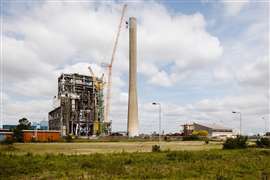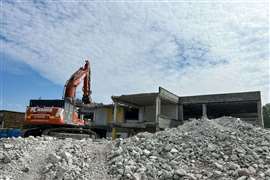Project report: Robot used for power plant demolition
21 November 2025
Once a prominent source of energy, the Hemweg 8 coal-fired power plant in Amsterdam is now a relic of a fading fossil-fuel era.
 Photo: Tadano
Photo: Tadano
When the plant was shut down in 2020, Sarens was tasked with dismantling its 175-meter-tall stack, working on behalf of Combinatie ACGH, which includes LEK sloopwerken, Vermeulen Sloop en Milieutechniek, and MNE Sloop & Demontage.
Sarens handled crane operations, lift planning, and assembly of the Tadano CC 38.650-1, while Combinatie ACGH carried out the demolition itself.
Tadano provided technical support, including crane retrofit, load chart expansion, and on-site assistance throughout the project.
The project demanded precision, innovation, and careful planning. “We’d already taken care of a similar demolition project in the Dutch municipality of Borsele with a Tadano PC 3800-1 back in July 2020. So basically, we were already familiar with the procedure needed for this kind of thing – as well as with the challenges and risks involved,” explains Sarens Project Manager Anton Mertens.
For the project, the team opted for the Tadano CC 38.650-1, equipped with a hydraulic demolition robot to dismantle the stack piece by piece from top to bottom, switching constantly between two heavy demolition tools.
Special crane configuration
The scale and complexity of the lift meant that the crane required a special setup. With a system length of 196 meters - including a luffing jib - and a lifting capacity of 25 tonnes at a 55-meter radius, the configuration exceeded standard load charts for the CC 38.650-1.
Sarens collaborated closely with Tadano to develop a solution. “Our initial analyses quickly showed that the CC 38.650-1 would be able to achieve the required lifting capacities without issue,” says Tadano Manager AC & CC Retrofit Christian Eickstädt.
“So after we received Sarens’ go-ahead to retrofit their CC 38.650-1 accordingly, we completed the load charts and updated the LMI load moment indicator on the Sarens crane.”
After retrofitting the crane and updating the LMI load moment indicator, Sarens was able to operate with confidence, supported on-site by Tadano personnel from the Netherlands and Germany.
Ultimately, the crane was configured with an 108-meter main boom featuring an 84-meter Boom Booster and a 90-meter luffing jib.
Counterweight was distributed as 225 tonnes on the superstructure, 50 tonnes of central ballast, and 245 tonnes of SL counterweight.
For the 54-tonne SWL hook blocks, two reeving setups were used to reduce tool-switching downtime: one with three wire ropes, the other with a single rope.
Setup and preparations
Transporting the CC 38.650-1 from Sarens’ headquarters in Wolvertem, Belgium, involved over 50 truck trips across four days.
Three assembly technicians completed the crane setup in five days, aided occasionally by crane operators. Safety inspections, camera installations on the jib tip, and cab monitors to provide optimal viewing angles added another two days to the preparation.
“When you consider the fact that we used a configuration that had never been used before and that we had to get a number of components from a different location, I have to say that we’re really happy with how the setup process turned out – especially since we had to make sure we wouldn’t be disrupting any other ongoing demolition work at the site,” notes Mertens.
Safety and lift management
Safety was a constant priority. To protect the crane from falling debris, double rows of containers were positioned in front of it, and the cab was shielded with a transparent cover.
Crane positioning was determined with wind direction in mind, and operations were paused if wind exceeded safe levels. Special attention was required when raising and lowering the boom due to the attached anti-dust spray system.
The demolition target was also aggressive: five meters per day, giving a total project duration of ten weeks. The CC 38.650-1 worked two shifts daily, handling 16-hour days with lifts conducted in a circular pattern around the stack.
The crane and team consistently achieved the planned pace, safely dismantling the stack as planned.
Project completion
With the stack removed, the Hemweg 8 site has taken another step toward transformation, leaving behind a cleared area ready for future redevelopment.
The combination of careful planning, a specialized crane configuration, and precise lift management ensured the work was completed on time and safely, marking the end of the coal-fired era in this part of Amsterdam.
CONNECT WITH THE TEAM









